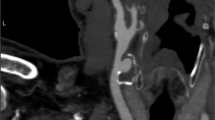Summary
The term “atheromatous pseudoocclusion” of the internal carotid artery (ICA) describes an extreme type of stenosing lesion which, during non-invasive procedure and conventional angiography is easily misdiagnosed as complete occlusion. Its recognition requires special sonographic and angiographic techniques. Nine subjects with pseudoocclusion could be observed during the last 12 months, most of them presenting minor strokes. Infarction suggesting a haemodynamic pathogenesis were demonstrated in seven of the cases by computed tomography. In seven of the eight subjects that were operated on, ICA reconstruction was successful. Since pseudoocclusion of the ICA is likely to progress rapidly to definite occlusion, the patient is severly jeopardized from periocclusive embolism into the major brain arteries. Immediate diagnostic clarification and emergency endarterectomy are mandatory.
Similar content being viewed by others
References
Zeumer H, Ringelstein EB, Klose KC (1981) Lakunäre Infarkte im Computertomogramm. Angiographische Befunde und differentialdiagnostische. Gesichtspunkte. RÖFO 4: 188–494
Wodarz R (1980) Watershed infarctions and computed tomography. A topographical study in cases with stenosis or occlusion of the carotid artery. Neuroradiology 19:245–248
Ringelstein EB, Zeumer H, Angelou P (1983) The pathogenesis of strokes from internal carotid artery occlusion. Diagnostic and therapeutical implications. Stroke (submitted for publication)
Hennerici M, Aulich A, Sandmann W, Freund HJ (1981) Incidence of asymptomatic extracranial arterial disease. Stroke 12: 750–758
Büdingen HJ, Reutern GM von, Freund HJ (1982) Doppler-Sonographie der extrakraniellen Hirnarterien. Grundlagen, Methodik, Fehlermöglichkeiten, Ergebnisse. Thieme, Stuttgart New York, S77–84
Clark OH, Moore WS, Hall AD (1971) Radiographically occluded, anatomically patent carotid arteries. Arch Surg 102: 604–606
Shucart WA, Garrido E (1976) Reopening some occluded carotid arteries. Report of four cases. J Neurosurg 45:442–446
Goldstone J, Moore WS (1978) A new look at emergency carotid artery operations for the treatment of cerebroyascular insufficiency. Stroke 9:599–609
Kusunoki T, Rowed DW, Tator CH, Lougheed WM (1978) Thromboendarterectomy for total occlusion of the internal carotid artery: a reappraisal of risks, success rate and potential benefits. Stroke 9:34–38
Hafner CD, Tew JM (1981) Surgical management of the totally occluded internal carotid artery: a 10-year study. Surgery 89:710–717
Mentzer RM, Finkelmeier BA, Crosby JK, Wellons HA (1981) Emergency carotid endarterectomy for fluctuating neurologic deficits. Surgery 89:60–66
Sekhar LN, Heros RC, Lotz PR, Rosenbaum AE (1980) Atheromatous pseudo-occlusion of the internal carotid artery. Neurosurgery 52:782–789
Lippman HH, Sundt TM, Holman CB (1970) The poststenotic carotid slim sign: spurious internal carotid hypoplasia. Mayo Clin Proc 45:762–767
Countee RW, Vijayanathan T (1979) Reconstruction of “totally” occluded internal carotid arteries. J Neurosurg 50:747–757
Gabrielsen TO, Seeger JF, Knake JE, Burke DP, Stilwill EW (1981) The nearly occluded internal carotid artery: a diagnostic trap. Radiology 138:611–618
Heros RC, Sekhar LN (1981) Diagnostic and therapeutic alternatives in patients with symptomatic “carotid occlusion” referred for extracranial-intracranial bypass surgery. J Neurosurg 54:790–796
Ringelstein EB, Zeumer H, Kruse W (1983) Differenzierte Leistungsanalyse der Dopplersonographie in der Diagnostik extrakranieller Karotisläsionen in Abhängigkeit vom Ausbildungsstand des Untersuchers (in preparation)
Torvik A, Joergensen L (1966) Thromboticand embolic occlusions of the carotid arteries in an autopsy material, Part 2: Cerebral lesions and clinical course. J Neurol Sci 3:410–432
Radue EW, Moseley F (1979) Carotid artery occlusion and computed tomography. A clinicoradiological study. Neuroradiology 17:7–12
Barnett HJM, Peerless SJ, Kaufmann JCE (1978) Stump of internal carotid artery-a source for further cerebral embolic ischemia. Stroke 9:448–456
Bogousslavsky J, Regli F, Hungerbüchler JP, Chrzanowski R (1981) Transient ischemic attacks and external carotid artery. A retrospective study of 23 patients with an occlusion of the internal carotid artery. Stroke 12:627–630
Burnbaum MD, Selhorst JB, Harbison JW, Brush JJ (1977) Amaurosis fugax from disease of the external carotid artery. Arch Neurol 34:532–535
Gastaut H, Naquet R, Vigouroux RA (1971) The vascular syndrome of the parieto-temporo-occipital “triangle” based on 18 cases. In: Zülch KJ (ed) Cerebral circulation and stroke. Springer, Berlin Heidelberg New York, pp 82–92
Zülch KJ, Behrend RCH (1961) The pathogenesis and topography of anoxia, hypoxia and ischemia of the brain in man. In: Gastaut H, Meyer JS (eds) Cerebral anoxia and the electroencephalogramm. Thomas, Springfield, IL, pp 144–163
Houser OW, Sundt TM Jr, Holman CB, Sandok BM, Burton RC (1974) Atheromatous disease of the carotid artery. Correlation of angiographic, clinical and surgical findings. J Neurosurg 41:321–331
Einsiedel-Lechtape H (1978) Secondary emboli: a frequent sequela of complete extracranial internal carotid artery occlusion. Neuroradiology 16:96–100
Ring BA (1971) Occlusio supra occlusionem: intracranial occlusions following carotid thrombosis as diagnosed by cerebral angiography. Stroke 2:487–493
Grotta J, Ackerman R, Correia J, Fallick G, Chang J (1982) Whole blood viscosity parameters and cerebral blood flow. Stroke 13:296–301
Wylie E, Kieffer E, D'Adatto M (1982) Asymptomatic extracranial arterial disease. Indications and results of surgical treatment. 3rd International Meeting on Vascular Pathology, Coimbra, Portugal, 17–25 May
Ahn HS, Rosenbaum AE, Shillito JS, Allen GS, Preziosi TJ, Heros RC (1982) Absence of thrombosis in the “occluded” cervical internal carotid artery when antegrade lower siphon opacification occurs: a new indication for carotid endarterectomy. XII.Symposium Neuroradiologicum, Washington, DC, 10–16 October
Newton TH, Couch RSC (1960) Possible errors in the arteriographic diagnosis of internal carotid artery occlusion. Radiology 75:766–773
Macpherson P (1978) Pseudo-occlusion of the internal carotid artery. J Radiol 51:5–10
Debaene A (1973) Layering of contrast media in the internal carotid artery related to angiographic circulation time and cerebral blood flow. Neuroradiology 6:71–77
Fisher CM, Ojemann RG, Roberson GH (1978) Spontaneous dissection of cervico-cerebral arteries. Can J Neurol Sci 5: 9–19
Sindermann F, Brügel R, Giedke H (1973) Spontaneous recanalization of internal carotid artery occlusions. Neuroradiology 7:53–56
Murphy MJ (1980) Progressive vascular changes in Moymoya syndrome. Stroke 11:656–658
Author information
Authors and Affiliations
Rights and permissions
About this article
Cite this article
Ringelstein, E.B., Berg-Dammer, E. & Zeumer, H. The so-called atheromatous pseudoocclusion of the internal carotid artery. Neuroradiology 25, 147–155 (1983). https://doi.org/10.1007/BF00455734
Received:
Issue Date:
DOI: https://doi.org/10.1007/BF00455734




